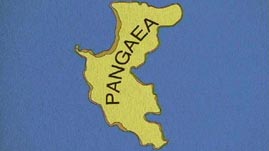Teachers' Domain - Digital Media for the Classroom and Professional Development
User: Preview

Source: Discovering Women: "Earth Explorer"
In the early 1900s, most geologists thought that Earth's appearance, including the arrangement of the continents, had changed little since its formation. This video segment adapted from Discovering Women describes the impact the theory of plate tectonics has had on our understanding of Earth's geological history, as we have become aware of our planet's ever-changing nature.
Plate Tectonics: An Introduction (Audio Description) (Video)
The similarity between jigsaw puzzles and maps is undeniable. Straight lines, wavy lines, jagged lines, and often arbitrary lines delineate political borders just as they define the edges of puzzle pieces. Continents appear to be cut from the same piece of Earth's crust. At least that's the picture the earliest mapmakers saw as they created the first images of our world.
As early as 1596, the Dutch mapmaker Abraham Ortelius wrote in his work Thesaurus Geographicus that the Americas must have been "torn away from Europe and Africa." He suggested that catastrophic earthquakes and floods must have been responsible for rearranging the continents. By the early 20th century, geologists still believed that such forces were responsible for many of the major changes to Earth's surface since its formation 4.6 billion years ago. However, the suggestion that these forces actually split and moved continents had been widely dismissed.
A few scientists, however, were convinced that the continents had once been connected and had then broken apart and moved to their present positions. One such scientist, Alfred Wegener, an astronomer and meteorologist by training, set out to find evidence to support this notion. Wegener applied his wide-ranging interests and scientific knowledge to support what he would ultimately call his theory of "continental drift". In addition to detailing the similarity between the coastlines of continents on opposite sides of the Atlantic, Wegener compared assemblages of fossilized plants and animals, as well as similar rock types found oceans apart. The patterns he saw helped support his theory that all continents were once connected and formed a single supercontinent, which has since split up and drifted apart.
How the supercontinent Pangaea broke apart and how the individual continents moved to their present locations were questions Wegener couldn't answer before he died. Despite an impressive collection of data on similarities among Earth's continents, Wegener had no knowledge of mid-ocean ridges, patterns of magnetic polarity, and many other pieces of evidence that led geologists to the current theory of plate tectonics.
 Loading Standards
Loading Standards Teachers' Domain is proud to be a Pathways portal to the National Science Digital Library.
Teachers' Domain is proud to be a Pathways portal to the National Science Digital Library.
